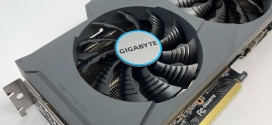SATA III Performance
Read
| Sequential | 512 | 4K | 4KQ32 | |
| GIGABYTE F2A88XN-WIFI | 426.6 | 297.2 | 20.77 | 247.1 |
| Gigabyte G1.Sniper A88X | 426.6 | 330.2 | 22.74 | 240.6 |
| Gigabyte Z77 | 435.3 | 29.6 | 29.33 | 347.3 |
Write
| Sequential | 512 | 4K | 4KQ32 | |
| GIGABYTE F2A88XN-WIFI | 443.6 | 415.8 | 87.05 | 221.0 |
| Gigabyte G1.Sniper A88X | 445.0 | 417.8 | 89.46 | 233 |
| Gigabyte Z77 | 470.4 | 465.5 | 84.14 | 333.7 |
We use CrystalDiskMark to test the SATA performance of the board. The test is done with the OCZ Vertx 4 256GB SSD. Interestingly, despite using the same chipset, the F2A88XN-WIFI actually performs slower than the G1.Sniper A88X. With the exception of the Sequential read, the F2A88XN-WIFI is trailing it’s sibling by a couple of percentage. Granted the difference is not that huge but it is there nonetheless.
WIFI Performance
To get some sense on just how fast the network transfer speed would be we placed our test system about 1.5 meter or 5 feet away from our Netgear D6200 router that is 802.11ac capable and transfered files from our Qnap NAS. We transfered 1.09 GB of data consisting of small files in multiple folders and also a single 3.68 GB IOS file. We measured the time required to finish the transfer with our trusty stop watch. For comparison, we include the wired Gigabit ethernet, Intel AC 7260, and the Athero AR9260 chip that is found on the F2A85XN-WIFI board and also included the result from the Ethernet port.
| Interfacce | 1.09 GB mixed files | 3.68GB IOS |
| Wired | 1 min and 2 sec | 1 min 42 sec |
| 802.11ac | 1 min and 55 sec | 2 min and 11 sec |
| 802.11n | 1 min and 52 sec | 2 min and 37 sec |
It is clear that from the result, the 802.11ac is edging closely to what the Gigabit Ethernet is able to offer. Obviously, the network overhead and the router that we are using can affect the performance but the the slowest component in the setup is the spinning hard drive that is inside of our NAS. We can see that when streaming large single file, the 802.11ac has a clear advantage over the 802.11n but when transferring small file sizes, there is virtually no difference in terms of transfer speed. One thing we did notice with the Intel AC 7260 is that the transfer speed seems to be more consistent compared to the Athero chip that was found on the A85X motherboard. So, the switch to the Intel AC7260 is definitely and improvement not only that you get a better transfer rate but also more reliable connection.
Power Consumption
At idle, the F2A88XN-WIFI with the AMD A10-6800K CPU and the integrated GPU consumes 33 watts of power and under load with x264 second pass, we noticed the system consumes 118 watts of power. When we push the system with Prime95, we noticed the system reached 126 watts of power. And pushing both the CPU and GPU with Furmark and the Prime 95, we noticed the system power consumption jumped to 156 watts. This is consistent with the G1.Sniper A88X that we have tested.
Review Overview
Performance - 8.5
Value - 9.5
Quality - 9
Features - 9
Innovation - 8
8.8
Gigabyte F2A88X-WIFI
For mini-ITX FM2+ motherboard, the F2A88XN-WIFI is packed with plenty of features that includes four SATA ports, 802.11ac, dual BIOS, and dual HDMI port. We definitely recommend anyone who is looking to build a small form factor PC with AMD Kaveri APU.
 Bjorn3D.com Bjorn3d.com – Satisfying Your Daily Tech Cravings Since 1996
Bjorn3D.com Bjorn3d.com – Satisfying Your Daily Tech Cravings Since 1996








You mention WIDI support but how do I go about actually enabling this feature?
the wireless adapter (Intel 7260) does support WiDi though to use WiDi, you would need also Intel CPU. AMD has their own Wireless Display where it is based on Miracast. If you are using Winodws 8.1, it should work. Though we have not yet test it.
http://community.amd.com/community/amd-blogs/amd/blog/2013/09/12/a-preview-of-amd-wireless-display-in-windows-81